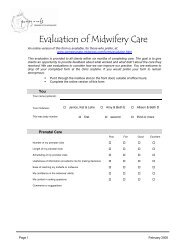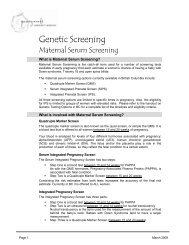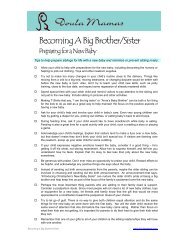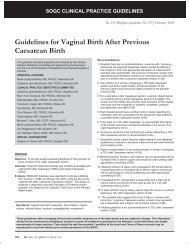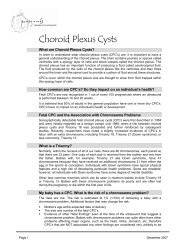BC Midwifery Fact Sheet - Pomegranate Community Midwives
BC Midwifery Fact Sheet - Pomegranate Community Midwives
BC Midwifery Fact Sheet - Pomegranate Community Midwives
Create successful ePaper yourself
Turn your PDF publications into a flip-book with our unique Google optimized e-Paper software.
February 2007<br />
<strong>Midwifery</strong> in British Columbia<br />
<strong>Fact</strong> <strong>Sheet</strong><br />
HISTORY<br />
• The government announced on March 16, 1995 the approval of regulations of governing<br />
midwifery and establishing the College of <strong>Midwives</strong> of <strong>BC</strong><br />
• In May 1996, the Health Professional Council released a draft of Bylaws for the College of<br />
<strong>Midwives</strong> of <strong>BC</strong>. This received Cabinet approval on April 13, 1997<br />
• In 1998, midwives were officially registered with the government and the College of <strong>Midwives</strong> of<br />
B.C.<br />
BACKGROUND<br />
• <strong>Midwives</strong> have been regulated by government and publicly funded since January 1998. This<br />
year, 2007 marks the 10 th Anniversary of this regulation<br />
• All services provided by Registered <strong>Midwives</strong> are covered by the Medical Services Plan and<br />
funded by the Ministry of Health<br />
MIDWIFERY PRACTICE<br />
• 128 midwives are registered in B.C. in 2007; 102 are currently practicing in B.C.<br />
• <strong>Midwives</strong> deliver 6.6% of babies each year in B.C.; The <strong>BC</strong> Perinatal Database Registry data<br />
shows midwives experienced an increase of deliveries from 4.8% in 2001/2002 to 5.7% in<br />
2003/2004<br />
• A midwife is licensed to care for 40 clients a year; this is a provincially-imposed cap<br />
• 2639 B.C. women in 2005 chose midwives to deliver their babies (approx. 40,139 B.C. women<br />
gave birth in the same year)<br />
• <strong>Midwives</strong> educated in B.C. complete a four-year university degree program and are required to<br />
register with the College of <strong>Midwives</strong>, the regulatory body for midwives in the province<br />
• The College of <strong>Midwives</strong>’ mandate is to ensure public safety; providing rules and regulations<br />
that protect women and infants<br />
• <strong>Midwives</strong> are experts in low-risk pregnancies and deliver excellent care to women; often<br />
spending 45 minutes each visit throughout the pregnancy and post-partum period<br />
GROWTH OF THE PROFESSION<br />
• The midwife program at the University of British Columbia accepts 10 applicants each year;<br />
approximately 8 to 10 graduates enter the market per year<br />
• Each year there are approximately 16-20 new midwives registered; U<strong>BC</strong> program or other<br />
sources (foreign trained or transfers from other provinces)<br />
Page 1 of 2
February 2007<br />
• In each health region the existing Department of <strong>Midwifery</strong> determines how many midwives can<br />
have hospital privileges – for example, in Victoria there are 13 midwives; 10 of whom have<br />
hospital privileges<br />
ATTRITION RATE<br />
Registered<br />
<strong>Midwives</strong> in <strong>BC</strong> –<br />
Jan.2007<br />
Non-Practicing New Registrants –<br />
since Apr.2006<br />
128 26 18 102<br />
Town/City<br />
# of <strong>Midwives</strong><br />
Greater Vancouver Area 56<br />
Victoria 13<br />
Saltspring Island 2<br />
Duncan 4<br />
Nanaimo 4<br />
Courtney 3<br />
Errington 1<br />
Comox 1<br />
Roberts Creek 2<br />
Nelson 4<br />
Cranbrook 2<br />
Kelowna 2<br />
Vernon 1<br />
Lister 3<br />
Prince George 3<br />
Total # practicing<br />
today<br />
• “midwifery services in rural communities are vulnerable to shifting labour and delivery services to<br />
regional centres including hospital closures and high GP attrition rates”<br />
• “Although one rationale for the regulation and public funding of midwifery in <strong>BC</strong> was increased<br />
access, to date rural women have not, for the most part, benefited from regulated midwifery”<br />
• “legislative deterrents including current fee-for-service models of remuneration that make practice in<br />
low-volume environment challenging ”<br />
(reference: Rural Women’s Experiences of Maternity Care: Implications for Policy and Practice, published July<br />
2007 www.ruralmatresearch.net )<br />
Page 2 of 2






